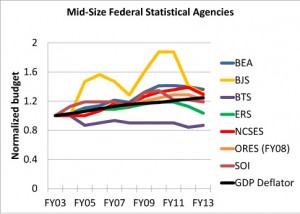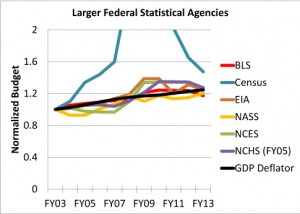Congress Finalizes FY13 Budgets
Cuts result for NIH, NSF, most federal statistical agencies
Steve Pierson, ASA Director of Science Policy
Weeks before President Obama released his FY14 budget request and six months into the fiscal year, Congress finalized the FY13 budget. For the most part, the budgets for the National Institutes of Health (NIH), National Science Foundation (NSF), and federal statistical agencies are their FY12 budgets reduced by the sequestration cut of 5.1%. The cuts will mean fewer and smaller grants for NIH and NSF and program cuts, hiring freezes, and reduced travel for the federal statistical agencies.
The full extent of the cuts, especially for the statistical agencies, will most likely be felt in FY14 unless the cuts can be reversed. If the budget reductions are not restored in the FY14 budget, further and more extensive program cuts appear inevitable.
For the actual FY13 budgets of NIH, NSF, and the federal statistical agencies, see Table 1 of the accompanying article on the FY14 budget request. (Note that not all FY13 levels have been confirmed.) The variation of the cuts—generally 2–11%—is due to varying additional rescissions necessary to meet the budget caps and exceptions—termed “anomalies”—that Congress made to the final continuing resolution.
In the final FY13 budgets, NSF, NIH, the Bureau of Economic Analysis (BEA), and the National Agricultural Statistics Service (NASS) all received anomalies. For NIH, NSF, and BEA, this means their budgets were only cut by 4.3%, 2.1%, and 2.6%, respectively. The NASS budget was increased by almost 5% so it could complete the quinquennial Census of Agriculture. Because NASS was ramping up its budget to conduct the Census of Agriculture, its final FY13 budget is still $13 million short of its FY13 request, so NASS is suspending 13 agricultural reports.
The Economic Research Service (ERS) received an anomaly that lowered its budget, which, together with sequestration and a rescission of 2.5% on the agriculture accounts, resulted in an 8.7% cut. As a result, it will not deliver 10 commodity newsletters and data products and will suspend another seven programs.
The U.S. Census Bureau’s budget is 11% lower than its FY12 level and 13% lower than its FY13 request (not accounting for $17.6 million transferred from the Working Capital Fund). The administration had requested a 3% increase for FY13 to increase work for the 2020 decennial census and for the quinquennial Economic Census. The Census Bureau will have to delay some of its 2020 decennial census planning work (which will likely result in increased 2020 decennial costs down the road) and scale back some of the Economic Census work. It also will have to implement other cost-cutting measures such as a hiring freeze and travel reductions. (Detailed effects of the Census Bureau cuts were scheduled to be released May 10.)
The budget for the Bureau of Labor Statistics (BLS) was cut 5%, resulting in the elimination of Measuring Green Jobs products, the Mass Layoff Statistics program, and the International Labor Comparisons program. BLS also will freeze hiring and take other cost-cutting measures.
The National Center for Health Statistics (NCHS) was spared any sequestration cuts because it is funded through Public Health Service Evaluation Transfer funds. The Bureau of Justice Statistics also seems not to have been cut from its FY12 budget, though its FY12 is smaller than previously thought ($41.3 million, instead of $45.0 million).
For the most part, the other statistical agencies are not reporting the effects of the FY13 budget cuts, but they are sure to include hiring freezes, reduced travel, and other cost-cutting measures.
For NSF and NIH, sequestration will mean fewer grants and/or smaller grants. In a March 1 Science article, “What It Means for Agencies to Be Under the Sequester,” Jeffrey Mervis reported that current NIH grantees will see their awards trimmed by several percentage points.
NIH also anticipates hundreds fewer awards than in FY12. Indeed, ASA President Marie Davidian received word that her National Cancer Institute grants are being funded at only 90% and for only six months, with funding for the next six months to be decided later. She noted how difficult such uncertainty makes planning.
For NSF, which commits its funding up front, current award amounts won’t be trimmed, but there will be hundreds fewer awards in FY13 than in FY12.
For more information, see Sequestration Impacts on NSF, NIH and Statistical Agencies .
The FY13 Statistical Agency Budget Cuts in Perspective of the Last Decade
To put the FY13 budget cuts for the statistical agencies into perspective, Figures 1 and 2 show the normalized budgets for the major federal statistical agencies back to 2003. The GDP deflator also is included to account for inflation.
Figure 1: The budgets of the seven mid-sized statistical agencies normalized to their FY03 levels, along with the GDP deflator to account for inflation. The Social Security Administration Office of Research, Evaluation, and Statistics’ budget is normalized (and adjusted for inflation) to its FY08 level, when the current accounting scheme was implemented. Except for FY13, the source of this data is the annual Analytical Perspectives OMB publishes with each fiscal year budget request.
For the smaller federal statistical agencies, the variability of the Bureau of Justice Statistics (BJS) budget and the declining purchasing power of the BTS budget stand out. According to The Consortium of Social Science Associations (COSSA), the first BJS increase was largely to resurrect the Arrestee Drug Abuse Monitoring Program as the Felony Arrest Drug Abuse Reporting Program. The second BJS increase was for the revitalization of the National Crime Victimization Survey.
For the BTS budget, which is determined by the authorization process rather than the appropriations process, purchasing power has declined at least 30% since FY03. The amount is likely more because 2004 legislation placed BTS under the control of the then to-be-created Research and Innovative Technology Administration (RITA), and RITA draws some of its budget from BTS. Some of this decrease can be attributed to management issues in the early 2000s.
On the congressional side, based on meetings I’ve had over the last year, BTS faces a number of challenges, starting with the challenging fiscal environment. For BTS specifically, congressional staffers seem to have a low awareness of BTS data products, and what little awareness they have is that the data are of more use to the private sector. BTS’s small budget also contributes to the problem in that it gets less attention than the larger items overseen by the committees with jurisdiction. There is also the Capitol Hill instinct of prioritizing projects in one’s home district/state district (versus good data on where and what to build.)
What also stands out in Figure 1 are the sharp drop to the Economic Research Service (ERS) budget over the last two years and the stagnant budget of the Bureau of Economic Analysis (BEA) over the last several years.
Figure 2: The budgets of the six larger statistical agencies normalized to their FY03 level, along with the GDP deflator to account for inflation. The NCHS annual budgets are normalized (and adjusted for inflation) to the FY05 level, when the current accounting scheme was implemented. The Census Bureau line peaks at 12.65 in FY10. Same source as for Figure 1.
The normalized budgets of the larger federal statistical agencies are shown in Figure 2. The Census Bureau budget, of course, stands out because of the decennial census operation. One also notices that the FY13 budget is well above the GDP deflator line, which can be at least partially explained by the American Community Survey being introduced in the mid-2000s to replace the decennial long form. Its annual budget is $240 million.
I’m convinced the Census Bureau budget would not be where it is if not for the work of its dedicated advocacy coalition. The Census Project has been especially active over the last year on the American Community Survey and budget for the U.S. Census Bureau. It organizes group letters to Congress, participates in visits to the Hill, and holds periodic meetings for Census Bureau stakeholders. The Census Project also has developed numerous materials in support of the ACS and has organized numerous, effective congressional briefings.
The National Center for Education Statistics’ (NCES) budget is noteworthy because of its relatively flat appropriations, except for the 40% rise in its budget from FY07 to FY09. One also notices the Energy Information Administration (EIA) budget has had large variations over the last several years.
Looking at the budget for the National Center for Health Statistics (NCHS), one notices a faster than inflation rise from FY06 to FY10. Much of the credit for this rise goes to an advocacy coalition called Friends of NCHS, which formed in 2006. Through an active and well-orchestrated advocacy campaign that includes letters to Congress and meetings with key House and Senate Appropriations Committee staff, Friends of NCHS has become a prominent voice. Unfortunately, no other federal statistical agency has such a dedicated coalition.












Hello,
What happened to the American Community Survey? Will it continue? Thank you.
Morris, fortunately, the Senate did not agree to the House’s elimination of the ACS or making it voluntary so the ACS remains as it was last year. You can expect similar amendments to the FY14 spending bills this year. For more on this, see this blog entry from one month ago: http://community.amstat.org/Blogs/BlogViewer/?BlogKey=6d475267-efb2-4082-a3f7-f501b7511b47. A more recent blog entry discusses briefly what the Canadians found in the conversion of their mandatory long-form Census to a voluntary survey: http://community.amstat.org/Blogs/BlogViewer/?BlogKey=6d475267-efb2-4082-a3f7-f501b7511b47.
While the ACS seems to have dodged a bullet for FY13, the threat remains and the Census Bureau has to deal with a major cut to its budget.
Welcome!
Amstat News is the monthly membership magazine of the American Statistical Association, bringing you news and notices of the ASA, its chapters, its sections, and its members. Other departments in the magazine include announcements and news of upcoming meetings, continuing education courses, and statistics awards.
ASA HOME
Departments
Archives
ADVERTISERS
PROFESSIONAL OPPORTUNITIES
FDA
US Census Bureau
Software
STATA
QUOTABLE
“ My ASA friendships and partnerships are some of my most treasured, especially because the ASA has enabled me to work across many institutional boundaries and
with colleagues from many types of organizations.”
— Mark Daniel Ward
Editorial Staff
Managing Editor
Megan Murphy
Graphic Designers / Production Coordinators
Olivia Brown
Meg Ruyle
Communications Strategist
Val Nirala
Advertising Manager
Christina Bonner
Contributing Staff Members
Kim Gilliam